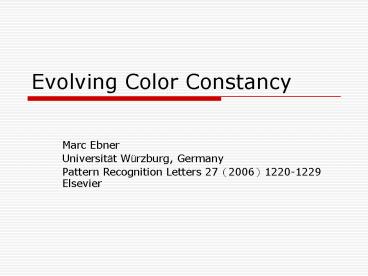Evolving Color Constancy PowerPoint PPT Presentation
1 / 24
Title: Evolving Color Constancy
1
Evolving Color Constancy
- Marc Ebner
- Universität Würzburg, Germany
- Pattern Recognition Letters 27(2006)1220-1229
Elsevier
2
Algorithms for color constancy
- Gamut constraint methods
- Perspective color constancy
- Color by correlation
- The gray world assumption
- Recovery of basis function coefficients
- Mechanisms of light adaptation coupled with
movements - Neural networks
- Comprehensive color normalization
- Committee based methods
- Algorithms based on the dichromatic color model
- Computation of intrinsic images
3
PE(Articial Retina)
- PEa rectangular grid of processing elements
- Better than neural nets, quite complicated.
4
Processing elements
- 1 PE for 1 image pixel
- 3 layers of PEs carrying out results on the 3
image bands red, green, and blue. - Estimate of the illuminant (color of input
pixel) - The data from other neighboring PEs
- Initially, ( pixel value )
5
(No Transcript)
6
Conclusion
- Only the current color channel(band)is used.
- Average data from neighboring elements.
7
Parallel algorithm
- The gray world assumption
- The reflectance ,
- distributed over the interval 0,1
- From PE,
- Nthe number of image pixels.
8
Parallel algorithm
- a(x, y)an estimate of local space average color
for each image pixel - N(x, y)a set of neighboring elements
- (1)Average the data
- (2)Slowly add the color of the current
pixel(psmall percentage)
9
Parallel algorithm
- The two equations, (1)(2),are carried out until
convergence. - 1000, 2000, 3000, 4000, 5000
10
(No Transcript)
11
- Local space average color
- 1 50 200 1000
- The parallel algorithm
- 1000
12
Reference
- Ebner, M., 2001. Evolving color constancy for an
artificial retina. Genetic Programming Proc. of
the 4thEuropean Conference, EuroGP 2001, Lake
Como, Italy. Springer-Verlag, Berlin, pp. 1122. - Ebner, M., 2004. A parallel algorithm for color
constancy. J. Parallel Distributed Comput. 64
(1), 7988.
13
Why Mondrian has been chosen
- First introduced by Edwin Land
- No curve and angle. No shade and texture.
- Neither uniformly colored nor uniformly bright.
- Resemble better the more colorful work of Klee or
Lohse. - Anya Hurlbert, 1999
14
Paul Klee
- ????????? Tunisian Gardens1919
- Ref. www.writedesignonline.com/history-culture/bau
haus.htm
15
Richard Paul Lohse
- Thematic series in 18 colours A, 1982
- Squares formed by colour groups 1944/2
- Ref. www.lohse.ch/bio_e.html
16
Mondrian
- Piet Mondrian, Composition A, 1923
- www.cartage.org.lb/en/themes/Arts/painting/20th-ce
ntury/art-sake/artsake.htm
17
Typical Mondrian stimuli
- Yellowish daylight bluish daylight
- 2 grey papers(third from the top on the left)
18
The experiment of Kraft and Brainard
- Look through a window into a box
- A grey test surface against the back wall
- A Mondrian-like panel
- A tube wrapped in
- tin foil
- A cube, pyramid and
- tube made from grey
- cardboard
19
Local surround
- Neutral-illuminant Orange-red
20
Spatial Mean
- Neutral-illuminant pale-red
21
Maximum Flux
- Neutral-illuminantyellow-illuminant
22
Results
- Color constancy
23
Anya Hurlbert, 2007
- Unknown why humans need color constancy. Color?
Shape? - How is color constancy measured? with difficulty.
Mondrians? - How is color constancy achieved? More than one
mechanism. Color processing in the brain. - Retinex
24
Reference
- Hurlbert A (1999) Colour vision is colour
constancy real? Current Biology 9R558R561. - Hurlbert, A. (2007). Colour constancy. Current
Biology, 17(21), R906-7. - JM Kraft and DH Brainard, Mechanisms of color
constancy under nearly natural viewing. Proc Natl
Acad Sci USA 96 (1999), pp. 307312.

